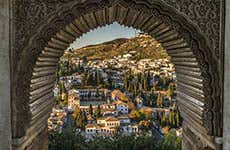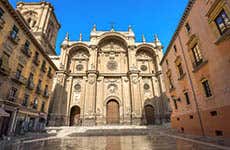
The Alhambra
Visiting the Alhambra in Granada is a must in order to learn about the history of the city and its significant Nasrid legacy. In 2017, over 2.7 million tourists from all over the world visited this unique architectural gem.
The Alhambra is very unique -its location, its dimensions, its architecture, and its history make it a very special site. Millions of tourists visit this courtly city every year eager to discover explore it. Its strategic location on the Al-Sabika hill, facing the Albaicin and with the Sierra Nevada in the background, makes the Alhambra part of the landscape and history of Granada.
This location was chosen as a way to show the might of the Nasrid dynasty so that its star monument could be seen from virtually every part of Granada. The Alhambra considered the eighth wonder of the world, means "red castle" and is an unparalleled Nasrid citadel, palace, and fortress. It's also the most visited monument in all of Spain!
History of the Alhambra
After the dissolution of the Caliphate of Cordoba in 1031, the territory occupied by the Muslims was divided into Taifa kingdoms, which eventually fell to the Christian troops in the 12th century.
For two hundred years, the kingdom of Granada became the only remaining bastion of Muslim power on the Iberian Peninsula. The founder of the Nasrid dynasty, Al-Ahmar, ordered the construction of the Alhambra and moved the royal residence from the Albaicin to this new location. It was then that Granada entered its period of greatest artistic splendor.
The walls and aqueduct of the Alhambra are the oldest part of the palatine city. Later, the Alcazaba and the main towers were built. During the 14th century, the three Nasrid palaces were built: the Mexuar, the Comares, and the Lions.
After the Catholic Monarchs took over the city in 1492, they carried out several reforms and built the convent of San Francisco. Later, his grandson Emperor Charles V ordered the construction of a palace named after him.
Between the 18th and 19th centuries, the Alhambra suffered a period of neglect for almost a hundred years until Napoleon's French troops occupied part of the palace and nearly destroyed it.
Finally, in 1870, the Alhambra became State property and was declared a National Monument.
What to see inside the Alhambra
The court city of Alhambra is made up of several areas that served different purposes:
The Alcazaba
This is the oldest part of the building and is located at the highest point of the hill. Its purpose was purely military, although it is believed that it may have served as a royal residence at some point. The Alcazaba is a large fortress protected by walls where the four main towers of the Alhambra are located. From them, you'll have a privileged view of the entire city, the Albaicin, and Sierra Nevada.
In the Alcazaba is the Plaza de Armas, which currently has the foundations of the quarters where the military forces were housed, as well as some dungeons and a beautiful garden area.
Nasrid Palaces
Each of the three palaces is associated with an era and a Nasrid king:
- Mexuar Palace: it is the oldest of the three and, therefore, the worst preserved. King Ismail I ordered it to be built and used it for political meetings and to impart justice. The main hall is full of tiles and original lattices of great value.
Palace of Comares or Divan: this palace is built around the courtyard of the Myrtles. Its main pool is one of the most famous images of the Alhambra. In total, three monarchs were involved in its construction. It houses the famous Throne Room, where politics were made, and rooms where parties were held.
Palace of the Lions or Harem: this is the private area of Sultan Mohammed V, who resided here with his family and his harem. Here is the famous Patio de Los Leones, the crown jewel of the Alhambra.
The Partal
It is the first residence of the Nasrid kings who settled in the Alhambra. Its construction dates back to the 13th century and is made up of a palace with a portico of five arches, the Torre de las Damas (Tower of the Ladies), and a large outdoor pond. It is also possible to see some small houses that were built years later.
Generalife Palace
It was the recreational residence of the sultan and his family. This villa is located a short distance from the Alhambra and stands out for its gardens, which were once orchards. The most striking part of the Generalife is the main courtyard, which represents the Muslim concept of paradise.
From the Generalife, you can see the entire Alhambra and the Darro valley.
Palace of Charles the V
The Palace of Charles V is one of the most outstanding works of the Renaissance in Spain. It stands out for its main facade and its circular arcaded courtyard with columns following the Roman style. Emperor Charles V decided to build this palace near the Alhambra for his own pleasure and that of his family.
Although its construction began in 1527, due to a lack of funds and internal revolts in Granada, the Palace of Charles V was not completed until the twentieth century. It currently houses the Museum of Fine Arts and the Museum of the Alhambra.
How to get to the Alhambra?
-
This monument of Granada is quite accessible in every way, even on foot. These are the ways to get to the Alhambra from the center of Granada:
Bus: lines C30 and C32, with a frequency of about eight minutes, connect the city center with the Alhambra-Generalife 2 stop.
-
Cab: the price of one way from the center of Granada is about 6 euros approximately.
-
Walking: although it is a steep walk, it is worth walking from Plaza Nueva along the Cuesta de Gomérez to the forest surrounding the Alhambra. It won't take you more than half an hour and there are several trails that will take you directly to the monument.
-
Guided Visit in English
- If you want to enjoy the true symbol of Granda up close and person, you can book the following tour: Alhambra Guided Tour. The number of visitors to the Alhambra is limited, so we recommend booking as far in advance as possible.
- If you'd like to take an even more complete tour of Granada, we recommend you book the following tour:

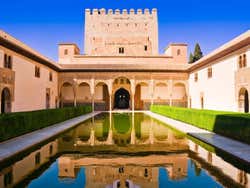
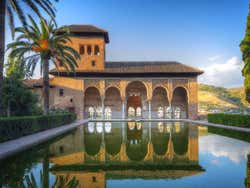
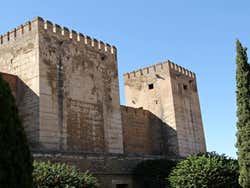
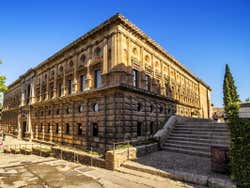
Schedule
Daytime visit:
April 1 to October 14: daily from 8:30 am to 8 pm
From October 15 to March 31: daily from 8:30 am to 6 pm
Night visit:
April 1 to October 14: Tuesday to Saturday from 10 pm to 11:30 pm
From October 15 to March 31: Fridays and Saturdays from 8 pm to 9:30 pm
Price
General admission: € 19.09 (US$ 22.47)
Children aged 12 to 15: € 12.73 (US$ 14.98)
European Union citizens, seniors over 65 years old and youth card: € 12.73 (US$ 14.98)
Children under 12 years: free admission
Gardens, Generalife and Alcazaba:
Adults: € 10.61 (US$ 12.49)
European Union citizens and youth card: € 7.42 (US$ 8.73)
Children under 12 years old: free admission
Alhambra & Nasrid Palaces Tour € 59 (US$ 69.46)
Transport
Bus: lines C30 and C32.
